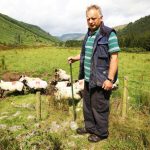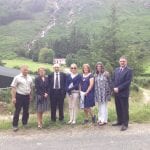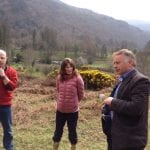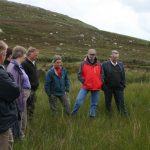Pat Dunne
Pat is a sixth-generation hill sheep farmer in Glenmalure valley, County Wicklow. He farms with his two sons, together keeping 1,100 ewes on 1,250 acres of commonage. The farm is 90% mountain grazing, mostly dry heath and upland grassland which is all designated SAC and NHA. The area is rich in wildlife, including grouse.
Pat takes his role as the current “keeper” of the family's long tradition of work on the uplands seriously and is anxious to hand-over the Wicklow hills in the best possible condition to the next generation of upland farmers. He feels that over the last 40 years there has been a slow but progressive decline in hill sheep farming, with the quality of the grazing declining along with the associated biodiversity, as bracken and Molinia start to take over. Pat was determined to work out a solution to this issue and was instrumental in establishing the new Sustainable Upland Agri-Environmental Scheme (SUAS) so that farmers can work together to the better of the uplands. The project will explore key management issues including vegetation management through targeted grazing, feeding and burning. Pat feels that it is important to keep these places ‘as living landscapes, not just wilderness’.
Though he recognises the challenges, Pat loves farming and ‘doesn’t know a better way of life’. He was one of the first Wicklow farmers to establish an “Agreed Access Route” on his lands. He is very involved in the local community, also in the Wicklow Uplands Council and at a National level on the IFA’s Hill committee.
NOMINATION DESCRIPTION
Pat is a 6th generation hill sheep farmer in Glenmalure, County Wicklow. Pat takes his role as the current “keeper” of the family's long tradition of work on the uplands seriously. Over the last 40 years, he has seen the slow but progressive decline in hill sheep farming on the mountains. The quality of the mountains for grazing his sheep has declined and so has the associated biodiversity.
Pat, as a member of the IFA Hill Committee and later as Chairperson, had first-hand experience of the challenges upland farmers were facing. He also has an insight into the solutions being proposed by national and European policymakers. Progress in finding solutions is slow. This reflected the very often different perspectives (farming and environment) of the stakeholders. However, Pat was generous with his time and made himself available to everybody in the pursuit of solutions. He has an integrity, recognised and acknowledged by all the stakeholders, in often tough and challenging times.
These experiences gave Pat greater insights into the challenges facing upland farmers. He, however, had a simple positive vision. He wanted to hand-over the Wicklow uplands to the next generation of upland farmers, including his own sons, so that the rural community would survive. He cared for people.
Pat started the process of developing a strategy to realise this vision. He would never describe it that way himself. He informed himself by listening and learning as a member of the Wicklow Upland Council and was one of the instigators of the vegetation sub-committee. This was established to provide a better understanding of the Wicklow upland habitats and biodiversity – what is there? what condition is it in? what can be done to address the problem?
He looked further afield for solutions. He was inspired by the approach and work of the BurrenLife Project and brought a group of upland farmers to Clare to create awareness among them of potential solutions to the challenges they faced. Pat built relationships with the other stakeholders in the Wicklow uplands. These included Teagasc, National Parks and Wildlife Services, Wicklow Deer Management Partnership and recreational users. He was one of the first Wicklow farmers to establish an “Agreed Access Route” on his lands. Pat was persistent in his quest to realise his vision.
Pat recognised the opportunity provided by the EIP initiative under DAFM's Rural Development Programme 2014 -2020. He assembled an Operational Group that assisted him to apply for funding successfully. The SUAS project (Sustainable Upland-Agri-environmental Scheme) started in March this year. At the project launch, he reminded the audience that the importance of the project lay in the fact that it would provide evidence to support policymakers and upland farmers to develop new upland schemes, keeping sheep farmers on the mountain producing meat and delivering public goods and it was not a quick-fix solution.
Pat’s achievements reflect his determination to provide a sustainable future for the uplands. This you might miss under his gentle, empathetic and often humorous temperament.
(Nominator: Owen Carton, Retired Teagasc)
Pat's own words regarding his involvement in the Heritage Bill: My involvement with the Heritage Bill was to see that the uplands were managed in a better way
To explain that when the burning dates were changed back in 2000 bringing the legal burning dates back from the 15th April to the 28th of February it became almost impossible to legally burn upland areas heather in particular and that meant it was getting out of control on very large areas and there was illegal fires being started in the months of May and June when birds were hatching and young chicks were out. What we wanted and always tried to explain that we wanted the mountains burned in a proper managed way that would mean a plan drawn out for each commonnage and if burning was needed it be done in a rotationally way rather than a wild fire destroying thousands of acres at worst possible time of year. We were looking at the bigger picture and I believe that given a chance the pilot scheme introduced will be a big improvement for farming and biodiversity




